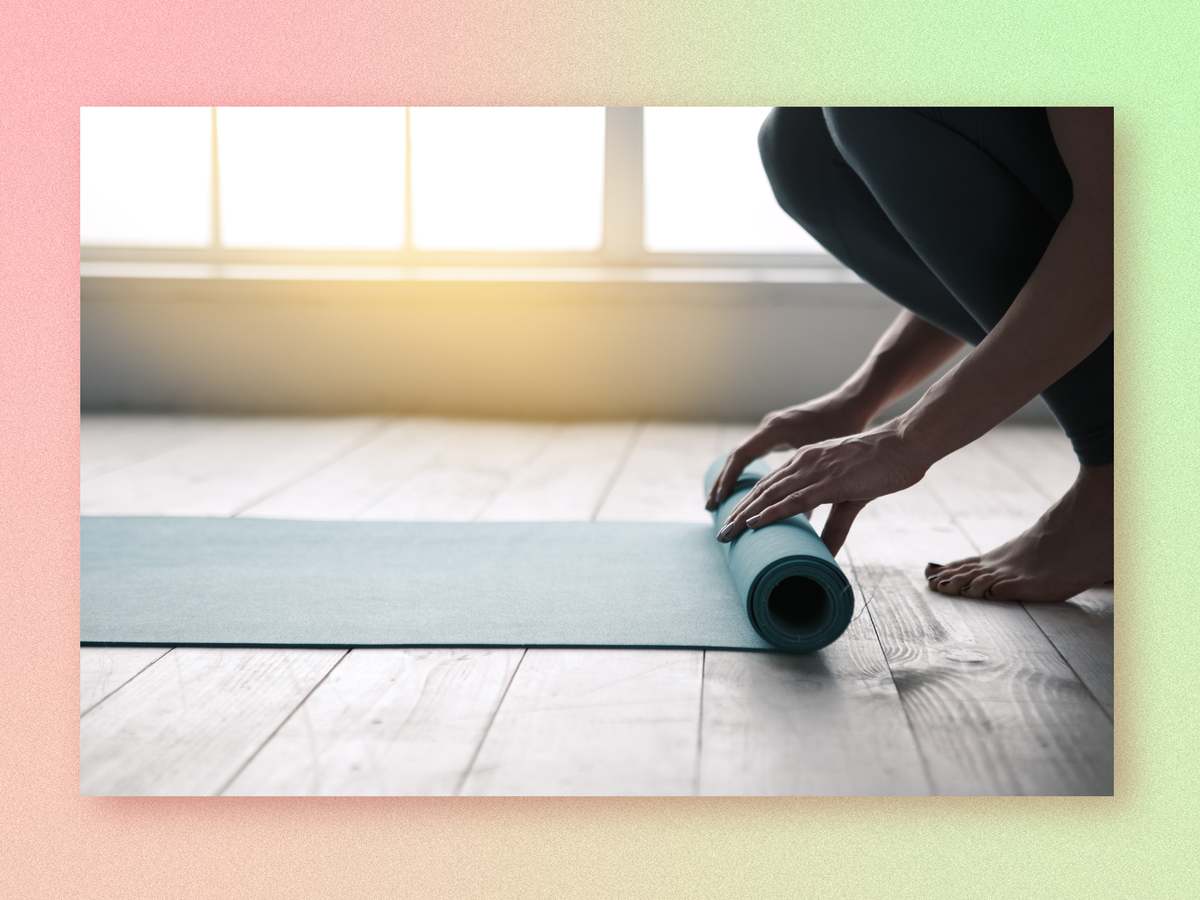Strong and solid midsections are widely sought after, with exercisers regularly subjecting themselves to endless sit-ups, planks and crunches in pursuit of one. But according to experts, there are more focused and effective ways to train your abs.
Ash Grossmann, a movement mechanics expert and founder of The Training Stimulus, says there are alternative exercises which offer plenty more bang for your buck. To prove it, he’s shared what he believes to be the best three-move abs workout you can do at home with just a single dumbbell, or a fairly heavy household object like a water bottle.
“Whenever somebody asks for the best workout, I always ask, ‘for what?’ Are you training to look good and have a nice six-pack, to be strong for heavy squats and deadlifts, or to hit the ball further in golf? What I’ve tried to do is tick as many boxes as possible with these three exercises.” he says.
The three moves cover the three planes of motion the body moves in: sagittal (up, down, forwards and backwards), frontal (side to side) and transverse (twisting). By doing this combination, the three moves not only promise to build mid-body strength and muscle, but can also improve your mobility and reduce your injury risk too.
How to do the best abs workout at home
- Extension bias lying leg raise: 2-4 sets of 6-15 repetitions
- Overhead side bend: 2-4 sets of 6-15 repetitions
- Staggered stance Russian twist: 2-4 sets of 6-15 repetitions
“Two to four sets of six to 15 reps is quite a big range to aim for, I’m aware, but for some people two sets of six reps might be tough, and for others four sets of 15 will be doable,” Grossmann explains. Try each exercise before you dive into the full workout, then decide on a target number of sets and reps that will challenge you without being unachievable.
For the weighted exercises, Grossmann recommends using a dumbbell or suitable household object that weighs between 2kg and 10kg. As you build strength in the positions required, you can gradually increase the weight over time.
“Once you’ve done the exercises a couple of times, you can start to push the threshold,” says Grossmann. “Like any exercise, the goal is to edge out of your comfort zone, but you don’t want to take a huge leap of faith beyond what you know you can do.”
Extension bias lying leg raise
Sets: 2-4 Reps: 6-15 Rest: 60-90 seconds
How to do it
- Lie on your back with a chair behind you and a cushion under your lower back. Make sure to arch your back over the cushion to get more of a stretch in the abs.
- Extend your arms overhead and grasp the two legs of the chair behind you for support.
- With your knees bent at roughly a 45° angle, crunch your abs to bring your knees towards your chest until your hips lift slightly off the cushion.
- Control your legs back to the starting position. To make this exercise more difficult, perform it with straight legs.
Benefits
With a regular sit-up, your hip flexor muscles kick in to lend your abs a hand as you curl your torso upwards. This exercise isolates the rectus abdominis (the muscles responsible for the six-pack shape) more effectively.
Thanks to the addition of the cushion, it also allows you to work through a wider range of motion by starting with your spine in an extended position, resulting in improved strength and muscle gains.
“The key thing this move does that a lot of abs exercises don’t do is it gives you a lot of stretch and a lot of activation, then we can take the abs through a big range of motion,” says Grossmann. “Training your abs in this position is going to have more carry over [to exercise and everyday life] than your classic sit-up or crunch.
“These classic moves work the rectus abdominis from a neutral position to a shortened position, whereas the extension bias lying leg raise works the muscles from a lengthened position to a shortened one.”
Read more: I’ve walked 10,000 steps a day for two years – these five benefits have persuaded me to keep it up
Overhead side bend
Sets: 2-4 Reps: 6-15 Rest: 60-90 seconds
How to do it
- Hold an object such as a weight plate, foam roller, dumbbell or water bottle overhead, with your arms outstretched above you and your hands roughly shoulder-width apart.
- With your legs straight, bend to your left and then to your right so the item you’re holding follows an arc.
- Keep reaching upwards throughout, and allow your hips to move in the opposite direction to your arms to accentuate the stretch down the side of your body. Avoid moving your body forwards, backwards or twisting in any way as you bend.
- Perform your target number of repetitions on each side.
Benefits
“What we’re doing here is creating a lot of length up the entire side of your body, which we call your lateral chain, then doing a standing sideways crunch to come back to neutral,” Grossmann says. “It’s hitting the obliques [sometimes colloquially called the side abs], but you’ll also use a little bit of your lats [the broad muscles in your back] and muscles in your lateral hip like the glute medius.”
Grossmann prefers this to a regular side bend because it recruits more muscles, creating “a body that works together rather than just strengthening a few isolated parts working on their own”. This, he says, has a ton of athletic benefits.
“Even in running there’s a lot of side bending as your head shifts over either foot, so you’re strengthening your ability to control that and retaining your ability to perform that motion,” Grossmann says.
“The other thing this really helps with is overhead pressing. When people can’t get into a good overhead position [where your arms are extended upwards], it’s often due to restrictions in their lateral chain – their obliques and their lats. By training them in a more lengthened position, the overhead side bend works as a mobility exercise as well as a core-strengthening exercise.”
Read more: Hyrox vs CrossFit: Which one should you choose?
Staggered stance Russian twist
Sets: 2-4 Reps: 6-15 Rest: 60-90 seconds
How to do it
- Start in a staggered stance with your right foot forward and your left foot extended behind you. Your right foot should be planted on the floor, while only the toes of your left foot should be touching the ground.
- Hold a dumbbell, foam roller, water bottle or even a towel with both hands in front of you, roughly level with your belly button. Your hands should be shoulder-width apart.
- Keeping your legs and hips steady and your eyes facing forwards, twist your trunk approximately 90° to your right, then return to the starting position.
- Complete the target number of repetitions, then repeat on the other side.
Benefits
You might be familiar with the standard Russian twist, where you sit down and shift a weight from one side of your body to the other, but Grossmann says the standing version offers some bonus benefits.
He likens the move to wringing out a towel, stretching your core muscles such as the obliques and deep-lying transverse abdominis by twisting your hips and shoulders in different directions.
“It’s a great way of working your rotational core, which again has a huge carry over to sports,” Grossmann says. “This carry over is a lot easier to visualise in terms of hitting a golf or tennis shot, throwing a ball or even kicking a football.
“Another benefit of this exercise is, because you’re standing, you develop the ability to transfer force from the floor to the hands. The classic Russian twist trains your abs, but because your feet are hovering you don’t get used to putting force into the floor and transferring that into hitting a ball or throwing a punch. That’s why just doing lying abs exercises leaves a lot on the table.”
Read more: ‘Badass’ Friends star Courteney Cox can do a perfect chin-up at 60 – you can too with these three tips
What is triplanar training and why should you be doing it?
This workout is a prime example of triplanar, or multiplanar, training. It works your body across all three planes of motion (sagittal, frontal and transverse), with the trio of exercises emphasising each one in turn.
“The reason why triplanar training is so important is that all joints in the body actually move in all three planes of motion, but we often don’t expose them to this,” Grossmann explains.
“Most exercises are very sagittal dominant, making you move forwards, backwards, up and down. That leaves a lot on the table in terms of movement variety, which gives you the freedom to move in various different ways through life. It also leaves a lot on the table from a muscle activation point of view. We can activate our muscles more fully by taking them through a wider range of motion – more stretch and more shortening.”
Grossmann adds that this workout also moves the spine through all six of its possible positions; flexion, extension, left and right lateral flexion, and left and right rotation.
Read more: Swap the gym for this 30-minute rucking workout to strengthen your legs and core
“This means we activate the rectus abdominis, the obliques and the transverse abdominis, which are the key core muscles, more than we would with traditional exercises,” he says.
“The other benefit [of training the abs in this way] is the integration with neighbouring muscles – the lats, the glutes, the upper back and the hip flexors. That means the body is going to work together as a network of joints and muscles rather than just one muscle at a time. So, in terms of bang for your buck, we’re killing many birds with three stones.”
However, the benefits of triplanar training are arguably outweighed by the drawbacks of neglecting it. This is because the body operates on an informal “use it or lose it” principle, and if we don’t train in all three planes of motion we can lose access to certain movements and positions.
“Whenever you lose movement options, the options you’re left with get overused,” says Grossmann. “Say you don’t move your spine in all three planes of motion, that means your hip or your knee might have to pick up the slack, and that leads to a lot of overuse issues like tendonitis.
“By maintaining 3D movement, we can stay more supple, activate our muscles better and distribute workload more appropriately throughout the body. This means we’re going to perform better, because there are more muscles doing each movement.
“We’re also going to lower our injury risk, because each body part or tissue has to do slightly less work when all of its teammates are pulling in the same direction. Whereas, with an isolated approach, it can create weak links in the chain, and weak links can lead to overuse injuries.”
Read more: Three unexpected exercises you need to add into your Hyrox preparations, according to an expert trainer




